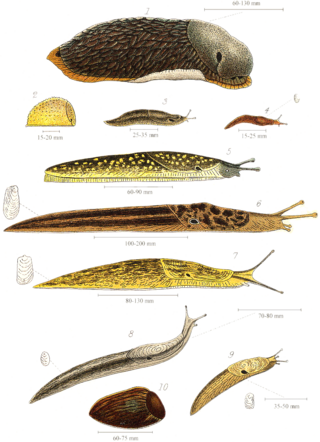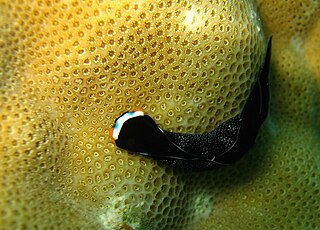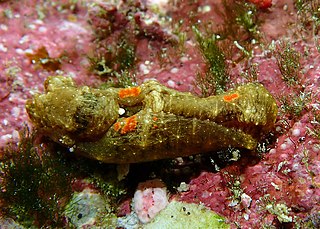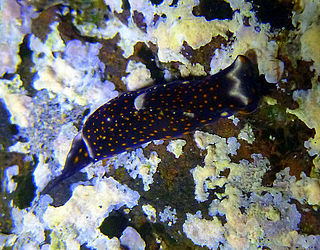
The clade Anaspidea, commonly known as sea hares, are medium-sized to very large opisthobranch gastropod molluscs with a soft internal shell made of protein. These are marine gastropod molluscs in the superfamilies Aplysioidea and Akeroidea.

Haminoeoidea is a taxonomic superfamily of small sea snails or bubble shells, marine opisthobranch gastropod mollusks in the clade Cephalaspidea, the headshield slugs and bubble snails.

Limax maximus, known by the common names great grey slug and leopard slug, is a species of slug in the family Limacidae, the keeled slugs. It is among the largest keeled slugs, Limax cinereoniger being the largest.

Slug, or land slug, is a common name for any apparently shell-less terrestrial gastropod mollusc. The word slug is also often used as part of the common name of any gastropod mollusc that has no shell, a very reduced shell, or only a small internal shell, particularly sea slugs and semi-slugs.

Elysia timida is a species of sacoglossan sea slug, a marine opisthobranch gastropod mollusk. Found in the Mediterranean and nearby parts of the Atlantic, it is herbivorous, feeding on various algae in shallow water.

Elysia pusilla is a species of small sea slug, a marine gastropod mollusk in the family Plakobranchidae. It is a sacoglossan.

Hydatina physis is a species of sea snail, a bubble snail, a marine opisthobranch gastropod mollusk in the family Aplustridae. Its common names include striped paper bubble, green-lined paper bubble, brown-lined paper bubble, and rose petal bubble shell.

Mariaglaja inornata, also called the inornate headshield slug, is a species of sea slug or headshield slug, a marine opisthobranch gastropod mollusc in the family Aglajidae.

Elysia diomedea is a species of sea slug, a marine gastropod mollusc in the family Plakobranchidae.

Aglaja is a genus of sea slugs, marine opisthobranch gastropod mollusks in the family Aglajidae. The genus is found in all warm and temperate oceans.
Aplysia morio, the Atlantic black sea hare or sooty sea hare, is a species of sea slug, a marine gastropod mollusk in the family Aplysiidae, the sea hares. It lives in warm waters in the Caribbean Sea and off the south and southeastern coast of the United States, where it feeds on seaweed.

Biuve fulvipunctata, the white-speckled headshield slug, is a species of sea slug or headshield slug, a marine opisthobranch gastropod mollusc in the family Aglajidae. This species is widespread in the Indian and Pacific Oceans but has invaded the Mediterranean Sea since 1961, despite apparently being absent from the Red Sea until recorded there in the 21st century. It is the only species in the monotypic genus Biuve.

Scolelepis squamata is a species of polychaete worm in the family Spionidae. It occurs on the lower shore of coasts on either side of the Atlantic Ocean.

Tubulanus superbus, commonly known as the football jersey worm, is a species of ribbon worm in the phylum Nemertea. Found in the northern Atlantic Ocean, the North Sea and the Mediterranean Sea, it occurs from the lower shore down to about 80 m (260 ft), on sand or gravel.

Tubulanus annulatus, commonly known as the football jersey worm, is a species of ribbon worm in the phylum Nemertea. It ranges across the northern Atlantic Ocean, the North Sea and the Mediterranean Sea, being present from the lower shore down to about 40 m (130 ft), on sand, gravel and other habitats.

Berthella stellata is a species of sea slug in the family Pleurobranchidae. It is found in shallow water in the Mediterranean Sea, the western Atlantic Ocean and the tropical and subtropical Indo-Pacific region.

Philinopsis speciosa, the blue-lined philinopsis, is a species of sea slug, a shell-less opisthobranch gastropod mollusc in the family Aglajidae. It is native to the Indo-Pacific region.

Tubulophilinopsis gardineri, the Gardiner’s philinopsis, or Gardiner's headshield slug is a species of sea slug, a shell-less opisthobranch gastropod mollusc in the family Aglajidae. It is native to the Indo-Pacific region.
Philinopsis depicta is a species of sea slug, an opisthobranch gastropod mollusc in the family Aglajidae. It is native to the Mediterranean Sea where it lives on the sandy seabed in shallow water. It is a predator.

Thuridilla vataae is a species of sacoglossan sea slug, a shell-less marine opisthobranch gastropod mollusc in the family Plakobranchidae. It is native to the tropical Indo-Pacific. It was first described by the French zoologist Jean Risbec in 1928; its specific name refers to the Bay of Anse Vata, just south of Nouméa, New Caledonia, where the type specimen was collected.

















